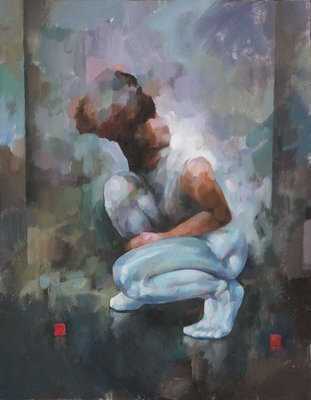Why Figurative Oil Painting Remains a Timeless Choice for Artists
Why Figurative Oil Painting Remains a Timeless Choice for Artists
Blog Article
The Duty of Feeling and Expression in Metaphorical Oil Paint: An Extensive Analysis of Topic Matter and Make-up
The interaction of emotion and expression in figurative oil paint functions as a vital lens where one can analyze the elaborate partnership between subject issue and composition. Artists harness different methods, from color selection to brushstroke characteristics, to cultivate emotional resonance within their jobs. This nuanced orchestration not only forms visitor understanding however likewise welcomes a deeper inquiry into exactly how these elements integrate to show the complexities of human experience. As we explore this abundant surface, one need to take into consideration just how particular situation studies light up the broader implications of these imaginative selections.
Understanding Emotion in Art
Emotion in art works as a powerful conduit for expression, allowing artists to share intricate sensations via their job. In figurative oil paint, this emotional depth is often represented with the representation of the human figure, recording the subtleties of human experience. The option of subject matter, shade combination, and brushwork all contribute to the emotional vibration of an item.
Artists often attract upon individual experiences, social issues, or global motifs to evoke feelings in the audience. As an example, a portrait may mirror susceptability, while a dynamic number in motion can signify liberty or chaos. These emotional threads link the audience to the art work, fostering a dialogue that transcends the visual tool.
Additionally, the interaction in between light and darkness can enhance psychological intensity, guiding the viewer's gaze and accentuating certain components within the make-up. Making use of appearance in oil painting further adds layers of complexity, welcoming a tactile response that enhances the psychological experience. In general, understanding feeling in art is crucial for valuing the subtleties that identify figurative oil paint, as it transforms simple depiction into an extensive expedition of the human problem.
Crucial Element of Make-up
In the world of figurative oil painting, the make-up works as the underlying structure that arranges aesthetic aspects and improves the emotional narrative. Necessary components of make-up include balance, comparison, centerpiece, and rhythm, each adding to the overall effect of the artwork.
Balance describes the circulation of visual weight within the painting, which can be achieved with unbalanced or symmetrical plans. A well-balanced structure offers stability, enabling the visitor to involve with the item sympathetically - figurative oil painting. Comparison, on the other hand, involves juxtaposing different components, such as dark and light or cozy and trendy shades, to guide the customer's eye and stimulate psychological actions
The focal point is crucial, as it guides interest to the most significant component of the paint, often highlighting the psychological core of the story. Via methods like color saturation or placement, artists can stress this area successfully. Rhythm pertains to the repetition of aspects, developing a sense of movement and circulation throughout the make-up. By skillfully integrating these key aspects, artists can craft psychologically resonant and compelling figurative oil paints that captivate and involve their target market.
Topic and Its Impact
Subject plays a pivotal function in figurative oil paint, as it not just works as the structure for the narrative yet also forms the viewer's interpretation and psychological involvement with the art work. The choice of topic-- be it a singular number, a group dynamic, or a thematic depiction-- directly influences the psychological environment communicated to the audience.

As an example, pictures typically stimulate individual connections, exposing the details of human expression and personality, while scenes depicting public tasks can create a sense of belonging or fond memories. In addition, the historical and social context of the subject improves the audience's understanding, prompting deeper representations on societal norms, values, and the human problem.
Different subjects likewise create varying levels of interaction; a dramatic dispute shown with numbers in stress might evoke sensations of anxiety or compassion, while calm landscapes can invoke harmony and consideration. Ultimately, the influence of subject in metaphorical oil painting is profound, as it acts as an avenue for psychological vibration, guiding the viewer's reaction and interpretation, and fostering a connection in between the artwork and the viewer. This interaction is essential for the effective communication of the artist's intent.
Techniques for Stimulating Sensations
The performance of figurative oil painting in sharing emotions is considerably influenced by the strategies used by the artist. Among one of the most crucial methods is making use of shade concept, where the strategic choice of colors can stimulate details emotional reactions. Warm colors, such as reds and oranges, usually evoke feelings of passion or hostility, while cooler tones like blues and environment-friendlies have a tendency to stimulate peace or sadness.
An additional crucial method is the manipulation of light and shadow, referred to as chiaroscuro. This method improves the three-dimensionality of figures, developing he has a good point dramatic contrasts that can intensify emotional deepness. The placement of light can direct audiences' emotions, highlighting specific components of the structure.
Brushwork additionally plays a vital function; loose, expressive strokes can convey power and spontaneity, whereas smoother methods could recommend harmony or accuracy. Furthermore, the arrangement of subjects within the structure can influence psychological effect. Close closeness can recommend intimacy, while distance might show seclusion.
Ultimately, the mix of these techniques makes it possible for musicians to craft stories that reverberate with the audience, changing a plain aesthetic experience right into an expressive emotional trip. - figurative oil painting

Study of Notable Functions
Taking a look at remarkable works of metaphorical oil painting exposes exactly how different methods are visit this website utilized to stimulate powerful feelings. One excellent case is Edvard Munch's "The Scream," where the altered figure and swirling background convey existential fear. Munch's use of advice shade-- deep blues and brilliant oranges-- heightens the emotional influence, showcasing just how palette options can form audience experience.
Another substantial work is Pablo Picasso's "Les Demoiselles d'Avignon." Below, strong brushstrokes and fragmented kinds reflect a turbulent psychological landscape, testing standard depictions of the women figure. Picasso's cutting-edge structure not just records the customer's interest yet likewise welcomes contemplation on motifs of identification and sexuality.
In Addition, Frida Kahlo's "The Two Fridas" supplies an emotional exploration of duality and self-identity. The different numbers, connected by a shared heart, exemplify Kahlo's psychological depth and individual narrative. figurative oil painting. Her careful interest to information and symbolic aspects serve to involve visitors on a natural level
These study highlight the profound link in between emotion and structure in figurative oil paint, disclosing how artists harness technique to communicate complicated sensations and stories that resonate throughout time and culture.

Verdict
To conclude, the interaction of emotion and expression in metaphorical oil painting considerably enhances the audience's experience and interpretation of the artwork. Through a careful choice of topic and compositional techniques, musicians share extensive stories that resonate on both global and personal degrees. The application of color theory, brushwork, and chiaroscuro additional magnifies emotional deepness, transforming each canvas into an effective reflection of the complexities of the human experience.
In figurative oil paint, this emotional deepness is often depicted with the representation of the human number, catching the nuances of human experience.Furthermore, the interaction between light and shadow can intensify emotional intensity, guiding the visitor's gaze and attracting focus to specific aspects within the composition. The usage of appearance in oil painting additionally includes layers of complexity, inviting a tactile response that enhances the psychological experience.The focal point is essential, as it guides focus to the most considerable part of the painting, commonly highlighting the psychological core of the story. Ultimately, the effect of subject matter in figurative oil painting is profound, as it serves as a conduit for emotional vibration, directing the audience's response and interpretation, and fostering a link in between the viewer and the artwork.
Report this page